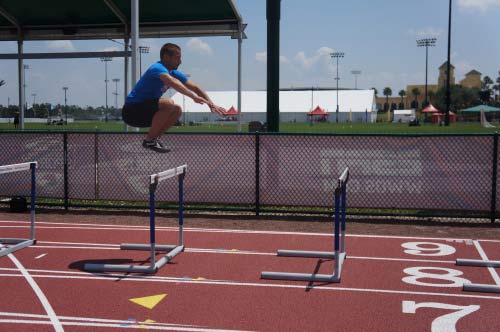To achieve success in anything, it’s important to find the common causes for failure. And do your best to avoid these causes.
Our team of fitness trainers in Singapore, guides thousands of clients each year towards their fitness goals. From this vast amount of experiences, observations, and data, we have discovered some of the major issues we need to help clients overcome. It is hard to get to your goals if these issues are not dealt with. Here are 14 ways that clients have sabotaged their results before they joined Genesis Gym’s personal trainers.
Sabotage method #1 – Follow a workout programme from a magazine or website blindly
Many of the workouts in your favourite bodybuilding or fitness magazine are not written for you or me. In men’s magazines, they usually have too much training to be effective. This sabotages results because the guys you see in magazines have some serious advantages over regular people which allow them to train like that but you and I do not.
- They are genetically gifted and are naturally quite athletic, lean and fit (we all have friends like this who eat badly and still have a “six-pack”)
- This is their job and they have much more time and energy to train and eat properly than the average stressed Singapore resident.
- They are often on performance-enhancing steroids which can have long term health negative consequences.
OR…
The training programmes are too soft and useless because (especially true for ladies magazines) they think that you can get great results with simple home training or 1kg dumbbells. If things were so easy, there would be many more very fit, lean and strong people walking around.
In general, choose a workout that is HARD but SHORT. And one where you are challenged to improve your strength continuously. A 45-minute duration training session (not including warm-ups) is a good starting point. You should not have energy to answer text messages or chit chat during this time if the workout is challenging enough.

Sabotage Method #2 – Have no plan
One of the questions my team and I always ask a client when they visit for the first time is: “What is the programme you are currently on?”
In almost all cases, this answer is that they are on a random mash-up of exercises and activities. These activities may even contradict the person’s training goals.
For example if you wanted to gain lean muscle while burning fat, long jogs are probably not your best option!
Training needs to have a plan because:
- Different activities result in different results. For example, lifting heavy weights for low reps makes you strong, and doing light weights many times gives you strength endurance.
- In most cases, if you combine activities wrongly you poor results because your body becomes confused. And does not know what ability to improve on.
- If you do not plan and instead train randomly, you cannot track your progress. If… this week you focused on heavy weight-lifting. Next week you decided to do canoeing. And the week after that you decided to do 800m runs on a track, it is very hard to determine if you are making progress!
- If you do not plan and train the same way all the time, you will stagnate as you body has already adapted to that kind of exercise.
Plan your workouts so that you can measure progress. We suggest doing the same programme for about 3-4 weeks, and measure the results.
Sabotage Method #3 – Changing your workout too often or doing random stuff
There is a fine line to be walked here.
On the one hand, if you don’t change your training methods often enough, you risk overuse injuries and lack of progress. Because your body has already adapted to the stimulus of the training.
However, if you change your programme too often or too randomly, your body has trouble adapting to anything at all.
For example, if you did heavy squats one day, light bench presses the next day, and ran a marathon on the day after that… your body would be confused as to what to get better at. In the end, it is possible that you will hardly get better at any of the three exercises.
What a waste of your precious time.
We suggest most people should change workouts after about six of the same workout. This is highly individual, but from my experience it varies from as many as 8 workouts for a total new trainee, to as few as one or two workouts for a gifted athlete.
Change your workout once you see stalled progress for two sessions.

Sabotage Method #4 – Not progressing yourself correctly
Your body will not get stronger, fitter, or leaner without making progress.
Progress can come in many ways, but it has to be measurable. For example, progress could mean an increase in weight lifted, a reduction in rest time required or an increase in the number of reps performed.
If you do two workouts without progress, you need to change your programme, take more time off or go for a period of lighter training to recover better.
Change the “type” of progress you aim for, every 8-12 weeks. For example, for one 8 week period, you may want to increase the maximum weight you can lift. For the next 8 weeks, you would aim to lift “do more sets each week” and after that you can aim to “do more reps within 20 minutes”.
Sabotage Method #5 – Do reps with inconsistent speed
If you do not control the speed of your exercises, you get different difficulty levels and training effects. For example, when you do a kipping chin-up (swinging your legs and body to help you up) you can get better at the skill of doing these kipping chin-ups but you may not actually be getting stronger at all.
For example, when our team trained the Guinness world record holder in pull-ups, we did perfect controlled reps. And no kipping pull-ups.
Just give the simple biceps curls a try with a three-second up, and a three-second down speed. You will probably get a much better arm workout than you are getting at the moment. Simply by moving the weight under control. This is unlike most trainees who use their entire body to swing the weight up.
To make sure all your reps are consistent, make sure that you perform them in a controlled manner. Yes, you will need to lower the weights you use, but you will end up with better strength gains.
Sabotage Method #6 – Do partial reps
For most of your training, you should do exercises with a full range of movement. Doing half chin-ups or half squats or half bench presses only develops strength in those “half” ranges. That can lead to muscle imbalances and poor flexibility, which increases the risk of injury and decreases the stability of joints. Use full range of motion exercises most of the time.
Most clients come in with a “target weight” in mind. While achieving a healthy weight is a good idea, it is not nearly as important as being at a healthy level of body fat.
We try to get “regular” people with jobs, families and other commitments down to 10-12 percent fat for men. And 16-19 percent for women. For most people, this means a nice flat stomach and probably visible abs.
A lady can be 57kg and 16 percent bodyfat and be in great health, but another lady who weighs 57kg at 35 percent fat is likely to be in very bad health.
They may be the same height and the same weight, but their health markers will be very different. Overall inflammation, brain function, blood fats, etc, will be much improved at a healthy body fat level.
Women (sorry ladies, it’s just an observation, nothing personal!) in particular have trouble making the distinction between weight and fat. So the key point I like to teach is this (depending on which studies you read)
One kilo of muscle burns an extra 100+ calories per day while you do … nothing!
It is like investing your money in a sure investment. It pays you back while you sleep (literally!).
In addition, it looks lean, feels firm and is attractive.
So, taking regular body fat readings is critical to success! It is a much more objective indicator than weight, which fluctuates with time of day, hydration status (i.e. did you pee?), hormonal fluctuations especially in ladies, water retention from illness or allergy etc.
Sabotage Method #8 – Too much cardio, not enough strength training
I am a big believer in having a healthy heart — and who isn’t. But the common misconception is that an hour on the treadmill is the best way to give you one.
A nice walk with your family or loved ones is a great idea which lowers stress and is thus good for you, and going for a cycle with your buddies is fun….
But using walks, jogs or cycling as your main form of exercise is not the best use of your time if you are trying to maximize your health within a busy schedule.
Assuming you do them with correct technique and progressive increments, strength training and interval training give far better benefits per minute of training than long slow cardio. They can boost metabolism for up to 36 hours after exercise.
Using the investment analogy, jogging for an hour only burns calories for an hour plus a bit more. But a properly designed strength training workout is like investing in something that pays you back a return for a long time.

As for the heart health issue, strength training benefits your heart because cardio does not have a monopoly on heart benefits. The cardiovascular system and heart, are not directly “trained” i.e. you don’t stick a mini gym in your chest and train your heart…
The heart responds to demands of the body. The heart does not care if you’re lifting weights, playing basketball or swimming. If the amount of training is high, or the basketball game is tough, or the swim is fast, your heart will get a positive training effect.
Everybody wants the best benefits in the least amount of time, so here are some guidelines:
- If you have limited time (3 hours per week or less to exercise), do purely strength training with short rest periods.
- If you have a bit more time (3-5 hours), add a bit of interval cardio into your exercise program.
- If you have more than 5 hours per week to exercise (quite rare in super busy Singapore), then add in 1-2 longer brisk walks if you want to.
Sabotage Method #9 – Trying to lose weight too fast.
While I am a big fan of fast results, I also want clients to have results that last long-term. When it comes to losing weight, the key message that my team and I tell our personal training clients is: Slow and steady wins.
The reason for this is that the faster you lose weight, the more likely you will drop your precious lean muscle, which slows metabolism and makes you put back the weight again in the long run.
A good target for slow, steady and maintainable progress is about 0.5kg per week (or about 0.7 per cent of your body weight) Actually, you will be losing more than this in terms of fat. But on a proper training and nutrition programme, you should also be gaining lean, attractive, firm muscle tissue.
So you may lose 1kg of fat, gain 0.5kg of muscle and lose only 0.5kg on the scale. But not to worry, it is the fat loss that matters, not the weight.
So, if you are 25kg overweight, it will take about year to drop that with no muscle loss.
After all, unless you have a serious health condition, you don’t get fat overnight. So don’t expect to see your six-pack overnight either!
If you progress at this “slow” pace, you will get a very amazing transformation, that lasts. Not one that “yo-yo’s” up and down.
So, keep it slow and steady, build the right habits, and you can keep your good results.
We certainly don’t want to end up like the contestants of the biggest loser who suffer long term health issues.
Sabotage Method #10 – Fear Fat in Your Diet
Many people try to avoid fat like it is a contagious disease. They take off the fat on meat. They eat “low fat” versions of everything from milk to cereal, and they treat butter like it is an instant heart attack.
I certainly don’t recommend bad fats, like those used in deep frying, or those which undergo artificial processing. These fats are called trans-fats or hydrogenated vegetable oils.
The process used to make these fats was originally designed to make candles from plant oils. So the next time you think about eating a potato chip, think about the fact that you are actually eating the chemical equivalent of a waxy candle…
These fats are totally foreign to your body, and may end up causing lots of damage.
However, natural fats, even saturated fats, are critical. Eating them will boost your health and actually make you stronger. Here are just some of their functions…
- Absorption of nutrients — many nutrients are fat soluble
- Formation of nerve lining and brain cells — makes you stronger and smarter
- Formation of muscle building and fat burning hormones — helps you achieve your fitness goals
- Blood sugar management — healthy fats encourage more nutrients to go into your healthy muscle cells and less to go into your fat cells.
Now, where do you get these healthy fats? From natural sources like grass fed meat, nuts, cold water fish, omega-e supplements, and good oils like olive oil, butter and coconut oil.
Coconut oil and butter are also excellent for cooking because they have a high smoke point and don’t turn cancer causing black easily.
Add in some of these oils to each of your meals. A teaspoon of fish oil, butter, or coconut oil with each meal would be a great start. Nothing bad will happen as long as you keep the refined carbohydrates low.
Sabotage Method #11 – Choosing exercises that are not appropriate for your fitness level
All exercise and sports have injury risks but there are ways to reduce their risk. All good coaches will do an assessment of you and your current muscle flexibility and function before starting you on a training programme, or sport.
If a person can hardly climb up stairs without pain, they certainly have no business running or jumping!

Every exercise has a “risk to benefit” ratio, which changes depending on who the client is. Jumping with a load on your back is excellent for a professional athlete who wants to improve speed, but is completely inappropriate for a person who has not exercised for the last 10 years. There will be benefits, but the risk is way too high and there are methods with better risk to benefit ratios.
Similarly, some of the “cool” exercises you see online may not be the best ones for you. Olympic lifts, plyometrics and lifting very heavy weights are great for the right person with the right level of training experience and motor skills.
However, most of the general population will still get great results with basic single-leg training like split squats, as well as dumbbell training done at a slow speed. Choose only exercises that you can do with perfect technique and no joint pain.
Sabotage Method #12 – Not taking care of injuries when they happen
From the hundreds of consultations my team and I do each year, we can see that most people have had some kind of injury before. Or, they are currently dealing with some kind pain.
Sometimes it is acute or sudden, for example, it is the result of an accident like falling down or a car accident.
Sometimes it is chronic and annoying, such as nagging shoulder, neck or back ache.
The two keys to handling injuries and pain in an effective way, while not using them as an excuse to get fat and lazy are…
Using the right treatment method for the problem you have
For example, if you got hit by a car, acupuncture is not what you need! You need to go to the A&E at a hospital.
- For all kinds of injuries and pain, perfect posture helps prevent them and/or help them heal correctly and more quickly. Genesis posture therapy is the only place in Asia that does this well.
- For accidents and torn ligaments like your Anterior Cruciate Ligament (ACL) in the knee, a hospital is the way to go.
- For minor strains, methods like acupuncture, massage, soft tissue work and the Trigenics will work well.
- For chronic annoying pain that is bone structure related, a good chiropractor can help.
- For chronic annoying pain that is muscle related, the soft tissue massage, FAT tool or the Trigenics method works well.
- All injuries do well with good nutritional support. A low inflammatory diet without refined food, along with nutrients like omega-3s and curcumin speed healing.

Train “around” the injury.
Whenever you have been injured, the best thing to do is to do safe exercises that do not make the injury worse. For example, in my early days, I had a slipped disc injury in my lower back from a sports accident and poor posture. It was super painful and I could not lift anything for a few weeks. In fact even getting out of bed or off the toilet seat hurt. However, two days later I was swimming. I was lifting light weights with exercises that did not involve the back, and as soon as the pain was duller, I started doing light stretches and exercises for my back to help it heal.
We never put a person at risk for further damage, but training smart and around an injury has the benefit of creating a growth hormone release, which aids healing of your injury.
It also prevents you from getting out of shape. This means you have a shorter road back to full health when the injury is healed.
Sabotage Method #12 – Too little sleep, and poor sleep quality
From our consultation records, about 75 per cent of people come in with what I would consider poor sleep quality. The key indicator of this is good energy in the morning. On a scale of 1 to 10, rate your morning energy, with 10 being happy and energetic and one being grouchy and sluggish.
If you rate lower than seven for more than about two days per week, improving your sleep will improve your fat burning and muscle building.
Tips:
- Sleep and wake up at the same time every day.
- Sleep in a dark room or wear an eye mask (If you can see your hand in front of your face, its not dark enough)
- Turn off all lights and electronic equipment such as phones, laptops, wifi routers
- Sleep slightly hungry, not starving, but certainly not after three roti-pratas.
- Take a magnesium supplement that contains multiple forms of magnesium. Three capsules at dinner and three before bed helps many people boost their sleep quality. Magnesium is depleted by stress and even hard exercise, so its great for most people.
Sabotage Method #13 – Using training to overcome bad eating habits
“Oh, right after this meal, I’m going for a run” is one of the things you may have heard or may even have said yourself as you stuffed down the last crumbs of cheesecake from the buffet table.
While I enjoy a good meal just like any of you, it is important to understand that it is next to impossible to out-train bad food habits.
Why? Even a hard training session uses about 600 calories per hour. However, that is just one BIg MAC worth of food. Add fries and a soft drink and you are up to more than 1,000.
While I’m not a big fan of calorie-counting as a lifestyle, it should be pretty clear that it is impossible to eat “whatever I want” and get great results.
The only exceptions to this reality are those who are genetically very adaptable to eating a lot (naturally skinny people who can see their abs and veins even if they don’t exercise or eat healthy at all) or those who do massive amounts of activity per day e.g. manual laborers or professional athletes.
Even this group would still benefit from healthy choices.
So I encourage you to make excellent food choices of healthy meats, veggies, good fats like fish and coconut oil, and unprocessed carbohydrates like sweet potatoes and some fruit.
Sabotage Method #14 – Not warming up correctly
Most people recognize that warming up before training is a good idea. However, if you read all the articles on the internet or in books on the subject of warming up, you may come away confused because there are a lot of opinions out there. Warming up incorrectly for your upcoming activity leads to poorer performance and increased injury risk.
Here are some tips that can save you time, and also get you warmed up in the right way for your training session.
- Use movement warmups or “dynamic” warmups for multi-directional or speed activities – For example, skipping, walking lunges, leg swings, are excellent before activities that require changes of direction and speed such as soccer, rugby, and sprinting.
- Use static stretching for tight parts of your body before all trainings – For example, if you are tight in your calves and hips, some static stretching (holds of 15 seconds or more) can be useful. The increased movement you get will allow you to squat, run or jump with better mechanics, reducing your risk of injury. Our stretching article will set you off on the right foot.
- Use warm-up sets for predictable activities like gym training. For example, if I were to do squats in the gym today, and I was trying to lift 100kg 10 times, I would warm up with weights up to about 80kg for a few reps. During these warm up sets I would use the exact same speed and movement that I would be using for the working sets.
I hope you can avoid these 14 things, which sabotage the results of your fitness programmes.
If you want guidance on how to implement a customized training and nutrition plan for yourself, we welcome you to join what is probably the best personal fitness training programme in Singapore by clicking the button below.
The Genesis Gym personal fitness trainers will design the nutrition, lifestyle and fitness plan for you and guide you to your fitness goals.
To your continued strength, health and happiness,
Coach Jonathan Wong
Director,
Genesis Gym Singapore
